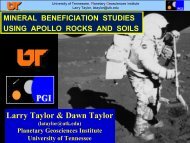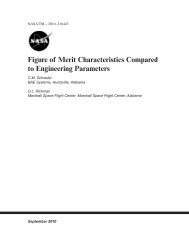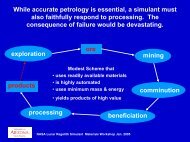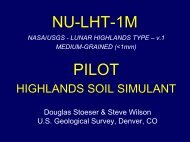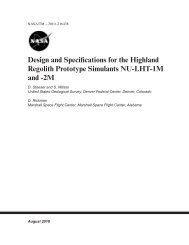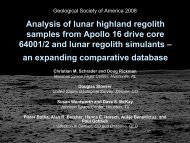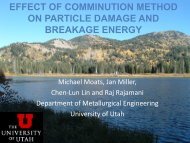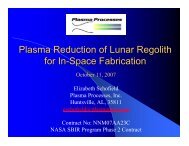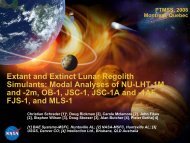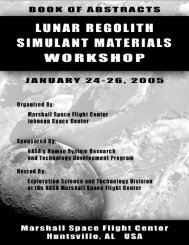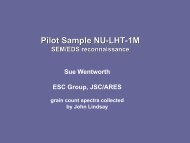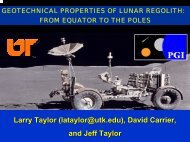Measurement of Particle Size and Shape Distribution For ... - Nasa
Measurement of Particle Size and Shape Distribution For ... - Nasa
Measurement of Particle Size and Shape Distribution For ... - Nasa
Create successful ePaper yourself
Turn your PDF publications into a flip-book with our unique Google optimized e-Paper software.
CE Diameter (µm) smoothed over 100 points<br />
0.7<br />
0.6<br />
0.5<br />
0.4<br />
%<br />
0.3<br />
0.2<br />
0.1<br />
0.0<br />
0.1 1 10 100 1000 10000<br />
CE Diameter (µm)<br />
Record 4: Lunar Highl<strong>and</strong>s Sim 026<br />
Figure 6-3 Number-based particle size distribution for 026.<br />
Volume transformation: CE Diameter (µm) smoothed over 30 points<br />
0.30<br />
0.25<br />
0.20<br />
%<br />
0.15<br />
0.10<br />
0.05<br />
0.00<br />
0.1 1 10 100 1000 10000<br />
CE Diameter (µm)<br />
Record 4: Lunar Highl<strong>and</strong>s Sim 026<br />
Figure 6-4 Volume-based particle size distribution for 026.<br />
Number <strong>and</strong> volume-based size distributions will generally differ as separate parameters are<br />
being used to determine the size (See attached Basic Principles <strong>of</strong> <strong>Particle</strong> <strong>Size</strong> Analysis). The<br />
number distribution tends to be more sensitive to small particles, while the volume-based<br />
distribution is more sensitive to larger particles that contribute more volume. The spikes in the<br />
high end <strong>of</strong> the volume distribution, especially for 026, are a result <strong>of</strong> a small number <strong>of</strong> large<br />
particles, which have a significant impact on the volume-based distribution. From the tables <strong>and</strong><br />
two above, it appears that on a number-basis, there are more small particles in both samples,



